Page 1

Topic 2
Before Driving
Front Seats
n Adjusting seat position
n Adjusting seatback angle
Moves the seat forward
1
Moves the seat backward
2
Tilts the seatback forward
1
Reclines the seatback
2
n Adjusting the seat cushion (For driver's seat only)
Raises and lowers the front of the cushion
1
Raises and lowers the entire seat
2
n Adjusting the lumbar support
Firmer
1
Softer
2
11
Page 2

Second Seats
Topic 2
Before Driving
Entering and Exiting
n Adjusting the seatback angle
n Tumbling the seats
Pull the lock release lever.
Stow the seat belt buckles and lower the head
restraints.
Fold down the seatbacks while pulling the lock
release levers and swing the seat up and forward until it locks in place.
Before Driving When Driving
Night Driving
Driving Comfort
Opening and Closing
Rain and
To return the seat to the original position, push
the red knobs.
What to do if ...
Customizing
Yo u r L e xu s
12
Page 3

Topic 2
Before Driving
Third Seats (If Equipped)
n Adjusting the seatback angle
n Folding up the seats
Pull down the lock release lever.
Stow the seat belt buckles.
Center seat belt buckle: Stow the tabs in the
cover set in the roof.
Lower the head restraint.
Center head restraint: Remove and stow in the
seatback.
Fold down the seatbacks, then unlock the seat
legs by pulling the release handles.
13
Page 4

Lift the seat sideward and retract the seat legs,
then attach the holding straps to the assist
grips to secure the seat.
When returning the seats, reverse the steps
listed.
n Removing the seats
Follow the procedure for “Folding up the seats” up to .
Retract the seat legs, then place the seats on
the floor.
Topic 2
Before Driving
Entering and Exiting
Before Driving When Driving
Night Driving
Driving Comfort
Rain and
Remove the seat lock covers and push the red
seat lock release knobs outward to remove the
seats.
When returning the seats, reverse the steps
listed.
Opening and Closing
What to do if ...
Customizing
Yo u r L e xu s
14
Page 5

Topic 2
Before Driving
Driving Position Memory System (If Equipped)
The seats can be returned to a previously set position by simply pressing a button.
The position of the steering wheel and the outside rear view mirrors is adjusted along with the
driver's seat.
Positions can be conveniently stored for the vehicle's primary drivers.
Set/Recall is possible when the ignition switch is “ON” and the shift lever is in the “P” position.
n Setting memory positions
While pushing the “SET” button, press the desired
memory button (“1” or “2”) until you hear a beep.
The current position of the seat, the outside rear
view mirror and the steering wheel are stored.
n Recalling memory positions
Press the desired memory button (“1” or “2”).
15
Page 6

Head Restraints
n Ve r ti c al ad ju st me n t
To r ai s e : push upward.
To l ow e r : push down while pressing the lock
n Horizontal adjustment (front seat only)
Move forward and backward.
release button.
Topic 2
Before Driving
Entering and Exiting
Before Driving When Driving
Night Driving
Driving Comfort
Rain and
Seatbelts
n Adjusting shoulder belt height (front and second outboard seats only)
To r ai s e : pull the anchor upward.
To l ow e r : depress the button and push the anchor
down.
Opening and Closing
What to do if ...
Customizing
Yo u r L e xu s
16
Page 7

Topic 2
Before Driving
Outside Rear View Mirrors
n Adjusting the mirrors
n Folding the mirrors
To select the mirror you wish to adjust (L or R),
1
use the select switch.
To adjust mirror angle, use the control switch.
2
The mirrors will automatically angle downwards
when the vehicle is reversing.
To disable this function, set the select switch to the
neutral position (neither L nor R selected).
To fold the mirrors back, push backward.
Inside Rear View Mirror
The mirror uses a sensor to detect light from vehicles behind and automatically reduces glare.
To turn auto mode ON/OFF, press the button.
The indicator comes on when auto mode is
turned ON.
17
Page 8

Before Driving
Steering Wheel
Up
1
Down
2
Tow ard th e dr iv er
3
Awa y fro m the driver
4
The steering wheel retracts automatically when the ignition key is removed to allow for easy exit and entry. The steering wheel returns automatically to its previously set position when the ignition key is inserted into the ignition switch.
Topic 2
Entering and Exiting
Before Driving When Driving
Night Driving
Driving Comfort
Rain and
Opening and Closing
What to do if ...
Customizing
Yo u r L e xu s
18
Page 9

Topic 2
Before Driving
19
Page 10

To pi c 4
Rain and Night Driving
Headlights................................................................ 31
Fog Lights ................................................................. 31
Windshield Wipers and Washers .................... 32
Rear Window Wiper and Washer ................... 32
Rear Window and Outside Rear View
Mirror Defoggers................................................. 33
Instrument Panel Light Control ....................... 33
Page 11

Topic 3
When Driving
Starting
n Starting the engine
n Stopping the engine
Engage the parking brake and shift the shift lever to “P”.
Turn the ignition key to the “LOCK” position.
n Ignition switch
Make sure the parking brake is engaged and the
shift lever is in “P”.
Depress the brake pedal.
Turn the ignition key to the “START” position.
“LOCK”
1
“A C C ”
2
Some electrical components such as the audio
system can be used.
“ON”
3
“START”
4
Once you turn the ignition key to the “START” position and release it, the cranking hold function continues to crank the engine until it starts.
21
Page 12

Automatic Transmission
Topic 3
When Driving
Entering and Exiting
n Shift positions
Parking Brake
P Pa r k
R Reverse
N Neutral (drive not engaged)
D Drive
4 Po siti on for e ngine br akin g
3, 2 Position for more powerful engine braking
L Position for maximum engine braking
The vehicle can only be shifted out of P when
the ignition switch is in the “ON” position and
the brake pedal is depressed.
Downshifting increases engine power for uphill
driving, or engine braking for downhill driving and
stopping.
To s e t: pull the parking brake lever firmly upward.
To r el e a s e : press and hold the lock release button
and lift the lever slightly before lowering it as far as it will go.
Before DrivingBefore Driving When DrivingWhen Driving
Night Driving
Driving Comfort
Opening and Closing
Rain and
What to do if ...
Customizing
Yo u r L e xu s
22
Page 13

Topic 3
When Driving
Tur n S i g nal L ev e r
To signal a lane change, move the lever partway and hold.
Emergency Flasher Switch
Left turn signal
1
Right turn signal
2
Engaging the emergency flasher switch causes all
the turn signal lights to flash.
The emergency flasher switch will work even if
the engine is off.
23
Page 14

When Driving
Cruise Control
Cruise control allows the driver to maintain a constant speed without having to operate the
accelerator pedal.
Use for highway driving or when traveling at a constant speed for long periods of time.
n Setting the speed
Press the ON-OFF button.
The system will turn on.
Accelerate or decelerate to the desired
speed, and then push the lever down.
This sets the cruise control at that speed.
n Adjusting the set speed
To increase speed: push the lever up.
To decrease speed: push the lever down.
Topic 3
Entering and Exiting
Before DrivingBefore Driving When DrivingWhen Driving
Night Driving
Driving Comfort
Rain and
Release the lever when the desired speed is
reached.
n Canceling
To temporarily cancel the cruise control, pull the
lever.
To turn the system off, press the ON-OFF button.
Depressing the brake pedal cancels the preset speed. To return to the preset speed, push the lever up.
Opening and Closing
What to do if ...
Customizing
Yo u r L e xu s
24
Page 15

Topic 3
When Driving
Trip Information Display
The following information concerning your vehicle is displayed.
n Display information
l Outside temperature (shown)
l Average fuel consumption
l Current fuel consumption
l Driving range
l Average vehicle speed
l Barometer
l Altimeter
l Elapsed time
n Changing the trip information display
The display changes sequentially each time the
“MODE” button is pressed.
Roll Sensing Of Curtain Shield Airbags Off Switch
This switch should only be used in situations where airbag inflation is not desired (such as
extreme off-road driving).
Push the “RSCA OFF” switch for a few seconds
with the ignition switch in the “ON” position.
The “RSCA OFF” indicator light will come on,
and the curtain shield airbags and seat belt
pretensioners will not activate in the event of a
vehicle rollover.
Push the switch again to turn roll sensing back on.
25
Page 16

When Driving
Center Differential Lock Switch
Use the center differential lock function if the vehicle’s wheels become stuck, or when driving on a slippery or bumpy surface.
To lock the center differential, push the switch.
The center differential lock and “VSC OFF”
indicator lights come on.
To unlock the center differential, push the switch
again.
Tire Pressure Warning Select Switch
Switches between the “MAIN” and “2nd” sets of
tire ID codes registered in the system.
Topic 3
Entering and Exiting
Before DrivingBefore Driving When DrivingWhen Driving
Night Driving
Driving Comfort
Rain and
Cigarette Lighter
To use, push in the cigarette lighter. When it has
heated sufficiently, it will automatically pop out
ready for use.
Opening and Closing
What to do if ...
Yo u r L e xu s
Customizing
26
Page 17

Topic 3
When Driving
Power Outlets
n 12V DC
n 115V AC
Designed for use with car accessories. The ignition switch must be in the “ACC” or “ON” position for this power outlet to be used.
Designed for use with electrical appliances. The
ignition switch must be in the “ON” position to
use this power outlet.
To use the power outlet, push the “AC 115V”
switch on the instrument panel.
Do not use the power outlet longer than necessary when the engine is not running.
Four-Wheel Drive Control Lever
“L” (low speed position)
1
Use this position for maximum power and
traction.
“N” (neutral position)
2
No power is delivered to the wheels. The vehicle must be stopped.
“H” (high speed position)
3
Use this position for normal driving on all types
of roads.
To shift between “H” and “L”, stop the vehicle, put
the shift lever in “N” and move the four-wheel
drive control lever.
27
Page 18

Damping Mode Select Switch
Adjusts the damping effect on the shock absorbers.
For driving on bumpy roads
1
For ordinary driving (city traffic etc.)
2
For moderate high speed driving
3
For high speed driving and sporty driving such
4
as on winding mountain roads.
Soft Hard
Topic 3
When Driving
Entering and Exiting
Before DrivingBefore Driving When DrivingWhen Driving
Rear Height Control Switch
Switches between high, normal and low rear height air suspension control modes.
Steps up one mode.
1
Steps down one mode.
2
“H” (high) mode: For driving on bumpy roads or
through water.
“N” (normal) mode: For ordinary driving.
“L” (low) mode: Allows easy access to the vehi-
cle.
“DAC” Switch
The Downhill Assist Control system helps to control vehicle speed when driving down
steep slopes.
l Shift the four-wheel drive control lever to the
“L” position.
l Push the “DAC” switch to turn the system on.
l If traveling at 15 mph (25 km/h) or less,
release the accelerator or brake pedal to acti-
vate the system.
To make full use of the engine brake, putting the
transmission in “L” or “2” is recommended.
Night Driving
Driving Comfort
Opening and Closing
What to do if ...
Yo u r L e xu s
Rain and
Customizing
Push the “DAC” switch again to turn the system
off.
28
Page 19

Topic 3
When Driving
29
Page 20

To pi c 3
When Driving
Starting ..................................................................... 21
Automatic Transmission ..................................... 22
Parking Brake ........................................................ 22
Turn Signal Lever.................................................. 23
Emergency Flasher Switch................................ 23
Cruise Control ...................................................... 24
Trip Information Display ..................................... 25
Roll Sensing Of Curtain Shield Airbags
Off Switch ............................................................... 25
Center Differential Lock Switch...................... 26
Tire Pressure Warning Select Switch ............ 26
Cigarette Lighter.................................................. 26
Power Outlets ....................................................... 27
Four-Wheel Drive Contro l Lever ................... 27
Damping Mode Select Switch.......................... 28
Rear Height Control Switch ............................. 28
“DAC” Switch ........................................................ 28
Page 21

To pi c 2
Before Driving
Front Seats................................................................ 11
Second Seats .......................................................... 12
Third Seats ............................................................... 13
Driving Position Memory System..................... 15
Head Restraints ..................................................... 16
Seatbelts................................................................... 16
Outside Rear View Mirrors ............................... 17
Inside Rear View Mirror...................................... 17
Steering Wheel ...................................................... 18
Page 22

Topic 1
Entering and Exiting
Keys
n Ke ys
Master keys
1
Work in every lock.
Val et ke y
2
Cannot lock/unlock the glove box.
Key number plate
3
Flat key
4
Use in emergencies. Works in every lock.
n Wireless remote control
“LOCK” button: Locks all doors
1
“UNLOCK” button:
2
“PANIC” button: Sounds the alarm
3
(Use this function if you notice anyone suspicious near the vehicle)
Press and hold the “UNLOCK” button to open all the windows.
7
Press once — Unlocks driver's door
Press twice — Unlocks all doors
(press and hold)
Page 23

Entering and Exiting
Theft Deterrent System
The theft deterrent system includes the following features to help protect your vehicle from
theft.
n Engine immobilizer system
The engine immobilizer system prevents the
engine from being started if an unregistered key
is used.
n Alarm
When forcible entry is detected, the alarm
attracts attention to the vehicle by sounding the
horn and flashing the exterior lights.
When all the doors are locked, the security indicator light comes on and begins to flash after
approximately 30 seconds to indicate that the
theft deterrent system is armed.
Topic 1
Before Driving
When Driving
Night Driving
Driving Comfort
Opening and Closing
Entering and Exiting
Before Driving
Rain and
To stop the alarm, start the engine or unlock the doors using the ignition key or wireless remote control. (The alarm will stop after several seconds.)
n Steering lock
The steering lock is engaged when the ignition
key is turned to the “LOCK” position.
What to do if ...
Customizing
Yo u r L e xu s
8
Page 24

Topic 1
Entering and Exiting
9
Page 25

To pi c 1
Entering and Exiting
Keys ............................................................................. 7
Theft Deterrent System ......................................... 8
Page 26

GAS STATION INFORMATION
Auxiliary catch lever
P. 28 6
Hood lock release lever
P. 28 6
Fuel filler door lever
P. 46
Fuel filler door
P. 46
Tire inflation pressure
P. 38 5
Fuel tank capacity 23 gal. (87 L, 19.1 lmp.gal.)
Fuel type Premium unleaded gasoline only P. 47
Cold tire inflation
pressure
Engine oil capacity
(Drain and refill)
With filler 6.5 (6.2, 5.5)
qt. (L, Imp.qt.)
Without filler 6.0 (5.7
, 5.0)
P. 3 85
“Toyota Genuine Motor Oil” or equivalent
Engine oil type
Oil grade: ILSAC multigrade engine oil P. 381
Recommended oil viscosity: SAE 5W-30
416
Page 27

The Quick Guide is not intended as a substitute for your
Manual
. We strongly encourage you to review the
Manual
and supplementary manuals so you will have a better
Contents
understanding of your vehicle’s capabilities and limitations.
Overview
To p ic 1
Entering and Exiting
lKeys P.7
lTheft Deterrent System P.8
lOutside Rear View Mirrors P.17
lInside Rear View Mirror P.1 7
lSteering Wheel P.18
Owner’s
Owner’s
To p ic 2
Before Driving
lFront Seats P.1 1
lSecond Seats P.12
lThird Seats P.1 3
lDriving Position Memory
System P.1 5
lHead Restraints P.16
lSeatbelts P.16
To p ic 3
When Driving
lStarting P.21
lAutomatic Transmission P.22
lParking Bra ke P. 2 2
lTu rn Si gn al Lev er P.23
lEmergency Flasher Switch P.2 3
lCruise Control P.24
lTrip Information Display P.2 5
lRoll Sensing Of Curtain Shield
Airbags Off Switch P.25
lCenter Differential Lock
Switch P.26
lTire Pressure Warning Select
Switch P.2 6
1
lCigarette Lighter P. 2 6
lPower Outl ets P.2 7
lFour-Wheel Drive Control
Lever P. 27
lDamping Mode Select
Switch P. 2 8
lRear Height Control
Switch P. 2 8
l“DAC” Switch P.28
Page 28

Topic 4
Entering and Exiting
lRear Window and Outside Rear
View Mirror Defoggers P. 3 3
l
Instrument Panel Light Control
Topic 5
Driving Comfort
lAir Conditioning System P.3 5
lAudio System P.37
lRear Seat Entertainment
System P. 3 9
lAshtrays P.4 0
lSeat Heaters P.4 0
lConsole Box P.4 1
lGlove Box P.41
P. 3 3
Rain and Night Driving
lHeadlights P. 3 1
lFog Lights P.3 1
lWindshield Wipers and
Wa s h e r s P.3 2
lRear Window Wiper and
Wa s h e r P.3 2
lCup Holders P.42
lPerso nal Lig hts P.4 3
lCompass P.4 3
lLexus Link System P.44
Topic 6
Opening and Closing
Before Driving When Driving
Night Driving
Driving Comfort
Opening and Closing
Rain and
What to do if ...
Customizing Your Lexus
Depending on specifications, the vehicle shown in the illustration may
differ from your vehicle in terms of color and equipment.
lDoor Locks P.47
lBack Door P.4 8
lPowe r Window s P.48
lMoon Roof P.4 8
lFuel Tank Cap P.4 9
lHood P. 5 0
Responding to warning/indicator lights
and other problems that may arise.
A list of features that can be customized.
What to do if ...
Customizing
Yo u r L e xu s
2
Page 29

Overview
See
P.5
Instrument Panel
Headlight switch
Turn signal lever
Fog light switch
P.31
P.23
P.31
Windshield wipers and
washer switch
P.32
Door lock switch
Driving position
memory switches
Power window switches
Hood lock release lever
Cruise control switch
P.47
P.15
P.48
Window lock switch
Fuel filler door lever
Ignition switch
P.48
P.50
P.49
P.24
P.21
3
Page 30

Emergency flashers
P.23
Trip-information display
Parking brake lever
P.25
P.22
Glove box
P.5
See
P.41
Automatic transmission second start switch
4
Page 31

Overview
Instrument Panel
Outside rear view mirror switches
Instrument panel light control
Center differential lock switch
“RSCA OFF” switch
P.25
Outside rear view mirror
heater switch
Power outlet switch
Power outlet
AUX adapter
P.33
P.27
P.27
P.38
P.17
P.33
P.26
Seat heater switches
Four-wheel drive control lever
Shift lever
P.22
“DAC” switch
Height control switches
Damping mode select switch
5
P.40
P.27
P.28
P.28
P.28
Page 32

Alphabetical index
Alphabetical index
A
A/C (Air conditioning system) ........ 162
ABS (Anti-lock Brake System) ........ 132
Active traction control......................... 132
Air conditioning system (A/C)
Air conditioning filter .........................315
Automatic air conditioning
system....................................................162
Airbags
Airbag operating conditions...........59
Airbag precautions for your
child.......................................................... 64
Airbag warning light ........................348
Curtain shield airbag
precautions ..........................................66
General airbag precautions ...........63
Locations of airbags............................56
Modification and disposal of
airbags.................................................... 67
Side airbag precautions ....................65
Side and curtain shield airbags
operating conditions .......................59
SRS airbags .............................................56
Alarm ............................................................. 51
Antenna ..........................................178, 269
Armrest.....................................................243
Ashtrays.................................................... 237
Audio system
Antenna....................................................178
CD player/changer ............................181
DVD information...............................209
DVD player..........................................200
DVD video/audio.............................205
MP3/WMA disc................................ 188
Optimal use............................................194
Radio..........................................................173
Rear sear entertainment
system..................................................200
406
Steering switches ................................198
Video CD................................................212
Automatic light control system............111
Automatic transmission ........................98
B
BA (Brake Assist)...................................132
Back door ...................................................... 11
Back-up lights
Wattage................................................. 386
Battery
Battery .................................................... 299
Checking............................................... 299
If the vehicle battery is
discharged ........................................370
Preparing and checking
before winter...................................... 146
Brake
Fluid.......................................................... 296
Parking brake........................................102
C
Care
Exterior....................................................272
Interior......................................................274
Seat belts ................................................275
Cargo capacity....................................... 140
Cargo hooks .......................................... 245
CD player ...................................................181
Center differential lock......................... 121
Chains .........................................................147
Child-protectors..........................................7
Child restraint system (CRS)
Definition ...................................................74
Installation .................................................77
Installing CRS with lower
anchorages............................................81
Installing CRS with seatbelts ...........78
Page 33

Alphabetical index
Installing CRS with top straps........ 83
Child safety
Airbag precautions ..............................64
Child restraint system .........................74
Child-protectors....................................... 7
How your child should wear
the seatbelt............................................32
Installing child restraints..................... 77
Moon roof.................................................43
Power window lock switch ...............41
Power window precautions.............42
Removed battery
precautions.........................................318
Seat belt precautions...........................33
Seat heater precautions...................241
Cigarette lighter................................... 238
Cleaning
Exterior....................................................272
Interior......................................................274
Seat belts ................................................275
Clock......................................................... 235
Compass ................................................. 253
Condenser.............................................. 295
Cooling system
Engine overheating...........................373
Cruise control
Cruise control........................................ 118
Cup holders.............................................. 231
Curtain shield airbags ............................56
Customizable features ...................... 398
D
Daytime running light system .............112
Defogger
Rear window......................................... 169
Side mirror.............................................. 169
Dimension................................................378
Dinghy towing .........................................160
Display
Trip information ...................................108
Do-it-yourself maintenance .............283
Door courtesy lights............................ 225
Door pocket............................................ 232
Doors
Door lock.....................................................6
Rear door child protector ....................7
Downhill assist control system ......... 130
Driver's seat belt reminder light ...... 351
Driving
Correct posture.....................................54
Procedures ..............................................95
DVD player............................................ 200
407
Page 34

Alphabetical index
E
Electronic modulated suspension ..129
Emergency, in case of
If a warning light turns on ..............347
If the engine will not
start........................................................367
If the shift lever cannot be
shifted from P...................................368
If the vehicle battery is
discharged .......................................370
If you have a flat tire .........................356
If you lose your keys.........................369
If you think something is
wrong...................................................343
If your vehicle becomes stuck..... 375
If your vehicle needs to be
towed ...................................................338
If your vehicle overheats................ 373
Engine
Compartment .....................................287
Hood........................................................286
How to start the engine..................... 95
If the engine will not
start........................................................367
Overheating.........................................373
Engine compartment cover ............ 288
Engine coolant temperature
gauge.......................................................103
Engine coolant
Capacity.................................................382
Checking............................................... 294
Preparing and checking
before winter......................................146
Engine immobilizer system.................. 49
Engine oil
Capacity ..................................................381
Checking...............................................289
Preparing and checking
before winter...................................... 146
Engine oil maintenance data ........... 292
Event data recorder ............................345
F
First-aid kit storage belt .....................246
Flat key.............................................................2
Floor mats................................................ 244
Fluid
Brake....................................................... 296
Power steering....................................297
Washer.....................................................301
Fog lights
Switch..........................................................113
Wattage................................................. 386
Foot light .................................................. 225
Front passenger's seat belt
reminder light ...................................... 351
Front passenger occupant
classification system............................ 69
Front seats
Adjustment ................................................ 13
Driving position memory ..................24
Front turn signal lights
Wattage................................................. 386
Fuel
Capacity ................................................380
Fuel gauge..............................................103
Gas station information ................... 416
Information ...........................................387
Refueling....................................................46
Fuel filler door........................................... 46
Fuses............................................................321
408
Page 35

Alphabetical index
G
Garage door opener.......................... 248
Gas station information....................... 416
Gauges.......................................................103
Glove box ............................................... 228
H
Head restraints.......................................... 26
Headlights
Replacing light bulbs .........................331
Switch............................................................111
Wattage .................................................386
Heaters
Seat heaters............................................ 241
Side mirror..............................................169
Hill-start assist control ......................... 132
Hood ......................................................... 286
Hooks
Cargo...................................................... 245
I
Ignition switch........................................... 95
Illuminated entry system ....................225
I/M test ..................................................... 282
Indicator lights.........................................105
Initialization
Items to initialize...................................401
Inside rear view mirror............................ 36
Instrument panel light control...........104
Interior lights
Interior lights........................................ 225
Wattage .................................................386
J
Jack
Replacing the wheel........................ 356
Jack handle..............................................356
K
Keys
If you lose your keys........................ 369
Key number plate .....................................2
Keys .................................................................2
Wireless remote control...................... 4
Kinetic Dynamic Suspension
System (KDSS).................................... 132
L
Lexus Link System................................ 257
Light bulbs
Replacing................................................ 331
Wattage.................................................386
Lights
Fog light switch...................................... 113
Headlights switch.................................... 111
Interior lights list..................................225
Replacing light bulbs......................... 331
Turn signal lever ....................................101
Vanity lights ..........................................234
Wattage.................................................386
Limited slip differential......................... 132
Luggage cover....................................... 246
409
Page 36

Alphabetical index
M
Maintenance
Do-it-yourself maintenance.........283
General maintenance..................... 279
Maintenance data..............................378
Maintenance requirements ...........277
Meter
Instrument panel light control ...... 104
Meters...................................................... 103
Mirrors
Inside rear view mirror.......................36
Side mirror heater...............................169
Side mirrors..............................................37
Vanity mirrors...................................... 234
Moon roof................................................... 43
MP3 disc.......................................................188
O
Odometer.................................................103
Off-road precautions
Driving....................................................... 137
Vehicle......................................................135
Oil
Engine oil ...............................................289
Outside rear view mirrors
Adjusting and folding ..........................37
Defogger switch...................................169
Driving position memory...................24
Outside temperature display...........236
Overhead console ...............................230
Overheating, Engine............................. 373
P
Parking brake.......................................... 102
Parking lights
Replacing light bulbs......................... 331
Switch............................................................111
Wattage................................................. 386
Personal lights........................................ 225
Power outlet ...........................................239
Power windows..........................................41
Q
Quarter window ................................... 245
R
Radiator.................................................... 295
Radio ................................................................ 173
RDS (Radio Date System) ..................175
Rear console box.................................. 229
Rear height control
air suspension .......................................123
Rear sear entertainment system
A/V input adapter...............................217
Headphone jacks.............................. 202
Remote control ..................................205
Rear seat
Folding up the third seat.....................18
Removing the third seat.......................21
Tumbling the second seat ................. 16
Rear step bumper ...................................... 11
Rear turn signal lights
Replacing light bulbs......................... 331
Wattage................................................. 386
410
Page 37

Alphabetical index
Rear window defogger........................169
Rear window wiper and washer ........117
Replacing
Fuses.......................................................... 321
Light bulbs ..............................................331
Reporting safety defects for
U.S.A. owners .................................... 404
Roof luggage carrier ..............................39
S
Seat belts
Adjusting the seat belt ....................... 28
Automatic Locking Retractor
(ALR) ........................................................31
Child restraint system
installation.............................................. 77
Cleaning and maintaining
the seat belts......................................275
Emergency Locking Retractor
(ELR)......................................................... 31
How to wear your seat belt............. 28
How your child should wear
the seat belt...........................................32
Pregnant women,
proper seat belt use..........................32
Reminder light....................................... 351
Seat belt extenders...............................32
Seat belt pretensioners........................ 31
Seat heaters.............................................. 241
Seating capacity ..................................... 144
Seats
Child seats/child restraint
system installation...............................77
Cleaning................................................. 274
Driving position memory.................. 24
Folding up the third seat..................... 18
Head restraint.........................................26
Properly sitting in the seat ................54
Seat adjustment .......................................13
Seat adjustment precautions.............14
Seat heaters............................................241
Removing the third seat.......................21
Tumbling the second seat ..................16
Security indicator................................... 106
Service reminder indicators ............. 106
Shift lever
If the shift lever cannot be
shifted from P ..................................368
Shift lock system....................................368
Side airbags................................................ 56
Side marker lights
Switch............................................................ 111
Side mirror
Adjusting and folding.......................... 37
Driving position memory.................. 24
Spare tire
Inflation pressure...............................385
Spark plug................................................382
Specifications .........................................378
Speedometer .......................................... 103
411
Page 38

Alphabetical index
Steering wheel
Adjustment...............................................35
Audio switches .................................... 198
Driving position memory...................24
Storage feature......................................228
Stuck
If your vehicle becomes stuck..... 375
Sun visors .................................................233
Switch
“2nd STRT” switch ...............................99
Center differential lock switch ........121
“DAC” switch .......................................130
Fog light switch.......................................113
Height control off switch..................123
Light switches........................................... 111
Power door lock switch........................6
Power window switch..........................41
“RSCA OFF” switch............................ 68
Window lock switch .............................41
Wipers and washer switch...............114
T
Tail lights
Switch ........................................................... 111
Theft deterrent system
Alarm............................................................ 51
Theft prevention labels..........................53
Tire inflation pressure ........................ 385
Tire information
Glossary.................................................395
Size ...........................................................392
Tire identification number ...............391
Uniform Tire Quality Grading....393
Tires
Chains....................................................... 147
Checking............................................... 302
If you have a flat tire .........................356
Inflation pressure ............................... 385
Information ...........................................390
Pressure warning system.............. 302
Replacing ..............................................356
Rotating tires........................................ 302
Size........................................................... 385
Snow tires................................................148
Tools...........................................................356
Total load capacity.................................144
Towing
Dinghy towing ......................................160
Emergency towing........................... 339
Trailer towing ........................................150
Trip information display ......................108
Trip meter ................................................. 103
Turn signal lights
Replacing light bulbs......................... 331
Switch..........................................................101
Wattage................................................. 386
V
Vanity lights
Vanity lights...........................................234
Wattage................................................. 386
Vanity mirrors............................................234
Vehicle identification number......... 379
Vehicle load limits ..................................144
VSC (Vehicle Stability Control) ......132
412
Page 39

W
Warning buzzers
Seat belt reminder ..............................351
Warning lights
“AIRBAG ON/OFF”
indicators..............................................106
Anti-lock brake system (ABS) ...349
Brake system........................................347
Charging system...............................348
Downhill assist control
indicator................................................106
Engine oil replacement
reminder light...................................350
Height control indicator...................106
Low engine oil pressure ................348
Low fuel level.......................................350
Low washer fluid................................350
Malfunction indicator lamp ..........348
Open door ...........................................350
Seat belt reminder light....................351
SRS airbags..........................................348
Tire pressure warning light.............351
Unengaged “P” ..................................349
“VSC TRAC” ......................................349
Warning reflector holder...................246
Washer
Checking.................................................301
Preparing and checking
before winter......................................146
Switch..........................................................114
Washing and waxing ...........................272
Weight
Cargo capacity ....................................140
Load limits...............................................144
Weight.................................................... 378
Alphabetical index
Wheels ....................................................... 313
Window glasses ........................................41
Window lock switch .................................41
Windows
Power windows.......................................41
Rear window defogger.................... 169
Washer ......................................................114
Windshield wipers......................................114
Winter driving tips................................. 146
Wireless remote control
Locking/Unlocking ................................ 4
Replacing the battery.........................317
WMA disc ................................................188
413
Page 40

Index
Alphabetical index ........................... 406
What to do if... ..................................... 414
405
Page 41

What to do if...
What to do if...
A tire punctures
The engine does not start
P. 35 6
If you have a flat tire
P. 49
Engine immobilizer system
P. 36 7
If the engine will not start
P. 370
If the battery is discharged
The shift lever cannot be
moved out
The engine coolant temperature
gauge enters the red zone
Steam can be seen coming
from under the hood
The key is lost
The battery is discharged
The doors cannot be locked
The horn begins to sound
If the shift lever cannot be shifted
P. 36 8
from “P”
P. 37 3
If your vehicle overheats
P. 36 9
If you lose your keys
P. 370
If the vehicle has a discharged battery
P. 6
Doors
P. 51
Alarm
414
The vehicle is stuck in mud or
sand
P. 37 5
If the vehicle becomes stuck
Page 42

What to do if...
The warning light or indicator
light comes on
nWarning lights
Brake system warning light Malfunction indicator lamp
or or
P. 34 7 P. 3 48
ABS warning light
or
P. 3 49 P. 35 1
“VSC/TRAC” warning light
P. 3 49 P. 35 1
Low fuel level warning light
P. 35 0 P. 3 49
SRS warning light
P. 3 48 P. 3 49
P. 34 7
If the warning light turns on
v
Driver’s seat
light
Front passenger’s seat belt
reminder light
Tire pressure warning light
Kinetic dynamic suspension
system warning light
Automatic transmission fluid
temperature warning light
belt r
eminder
P. 35 1
Open door warning light
P. 35 0 P. 3 49
Charging system warning
light
P. 3 48 P. 3 50
Low engine oil pressure
warning light
P. 3 48
Unengaged “Park” warning
light
Low washer fluid warning
light
415
Page 43

Reporting safety defects for U.S. owners
If you believe that your vehicle has a defect which could cause a crash
or could cause injury or death, you should immediately inform the
National Highway Traffic Safety Administration (NHTSA) in addition
to notifying the Lexus Division of Toyota Motor Sales, U.S.A., Inc. (Tollfree: 1-800-25-LEXUS).
If NHTSA receives similar complaints, it may open an investigation,
and if it finds that a safety defect exists in a group of vehicles, it may
order a recall and remedy campaign. However, NHTSA cannot
become involved in individual problems between you, your dealer, or
Lexus Division of Toyota Motor Sales, U.S.A., Inc.
To contact NHTSA, you may either call the Auto Safety Hotline tollfree at 1-888-327-4236 (or 366-0123 in Washington, DC area) or
write to: NHTSA, U.S. Department of Transportation, Washington, DC
20590. You can also obtain other information about motor vehicle
safety from the Hotline.
404
Page 44

For US owners
7
Reporting safety defects for
U.S. owners................................ 410
403
Page 45

6-3. Initialization
Items to initialize
After reconnecting or performing maintenance on the battery, the following items must be initialized for normal system operation.
Item When to initialize Reference
Power window • After reconnecting or changing the
Moon roof P. 43
Engine oil maintenance
data
battery
• After changing a fuse
•After changing engine oil P. 29 2
P. 41
6
Vehicle specifications
401
Page 46

6-3. Initialization
402
Page 47

6-2. Customization
Customizable features
Your vehicle includes a variety of electronic features that can be personalized to your preferences. Programming these preferences requires specialized equipment and may be performed by an authorized Lexus
dealership.
Some function settings are changed simultaneously with other functions being customized. Contact your Lexus dealer for further details.
Item Function Default setting
Wireless remote control ON OFF
Driver's door
unlocked in 1step, all doors
unlocked
in 2-steps
30 seconds 60 seconds
Wir ele ss
remote control
(
→P. 4 )
Unlocking operation
Time elapsed before automatic door lock function is
activated if door is not
opened after being
unlocked
Operation indicator
(Emergency flashers)
Operation indicator
(Buzzer)
Panic function ON OFF
Buzzer sounds when
pushing the “LOCK” button with any door not
closed.
Customized
setting
All doors
unlocked
in 1-step
ON OFF
ON OFF
ON OFF
398
Page 48

6-2. Customization
Item Function Default setting
Driver's door
unlocked in 1-
Unlocking using a key
step, all doors
unlocked
in 2-steps
Speed-detecting auto-
Door lock
(
→P. 6 )
matic door lock function
Opening driver's door
unlocks all doors
Shift the shift lever to “P”
unlocks all doors.
Shift the shift lever to position other than “P” locks
all doors.
Linked door lock opera-
tion
Power windows
(
→P. 41 )
Linked door key opera-
tion
Open and close
Wireless remote control
linked operation
Customized
setting
All doors
unlocked
in 1-step
OFF ON
OFF ON
ON OFF
ON OFF
ON OFF
Open only
Close only
ON OFF
6
399
Vehicle specifications
Page 49

6-2. Customization
Item Function Default setting
Linked door lock operation
Linked door key operation
Open and close
Linked operation of com-
Moon roof
(
→P. 4 3 )
ponents when door key is
used
Slide only Tilt only
Wireless remote control
linked operation
Linked operation of components when wireless
Slide only Tilt only
remote control used
Light sensor sensitivity Level 3 Levels 1 to 5
Automatic
light control
system
(
→P. 111)
Tim e e lap sed b efo re
headlights automatically
turn off after doors are
closed
30 seconds
Customized
setting
ON OFF
Open only
Close only
ON OFF
0 seconds
60 seconds
90 seconds
Daytime running light ON OFF*
Time elapsed before lights
turn off
Illumination
(
→P. 22 5)
Operation when the
doors are unlocked
Operation after the ignition switch is turned to the
“AC C ” po s i t i on
*: Vehicles sold outside Canada
400
15 seconds
7.5 s econ ds
30 seconds
ON OFF
ON OFF
Page 50

6-1. Specifications
Maintenance data
Dimensions and weight
Overall length 188.2 in. (4780 mm)
Overall width 74.0 in. (1880 mm)
Overall height
Wheelbase 109.8 in. (2790 mm)
*1
73.0 in. (1855 mm) *
74.6 in. (1895 mm)*
2
3
Tr e a d
Vehicle capacity weight
(Occupants + luggage)
With third seat
Without third seat
Towing capacity 6500 lb. (2948 kg)
1
*
: Unladen vehicle
2
*
: Without roof luggage carrier
3
*
: With roof luggage carrier
Front 62.4 in. (1585 mm)
Rear 62.4 in. (1585 mm)
1200 lb. (544 kg)
1000 lb. (454 kg)
378
Page 51
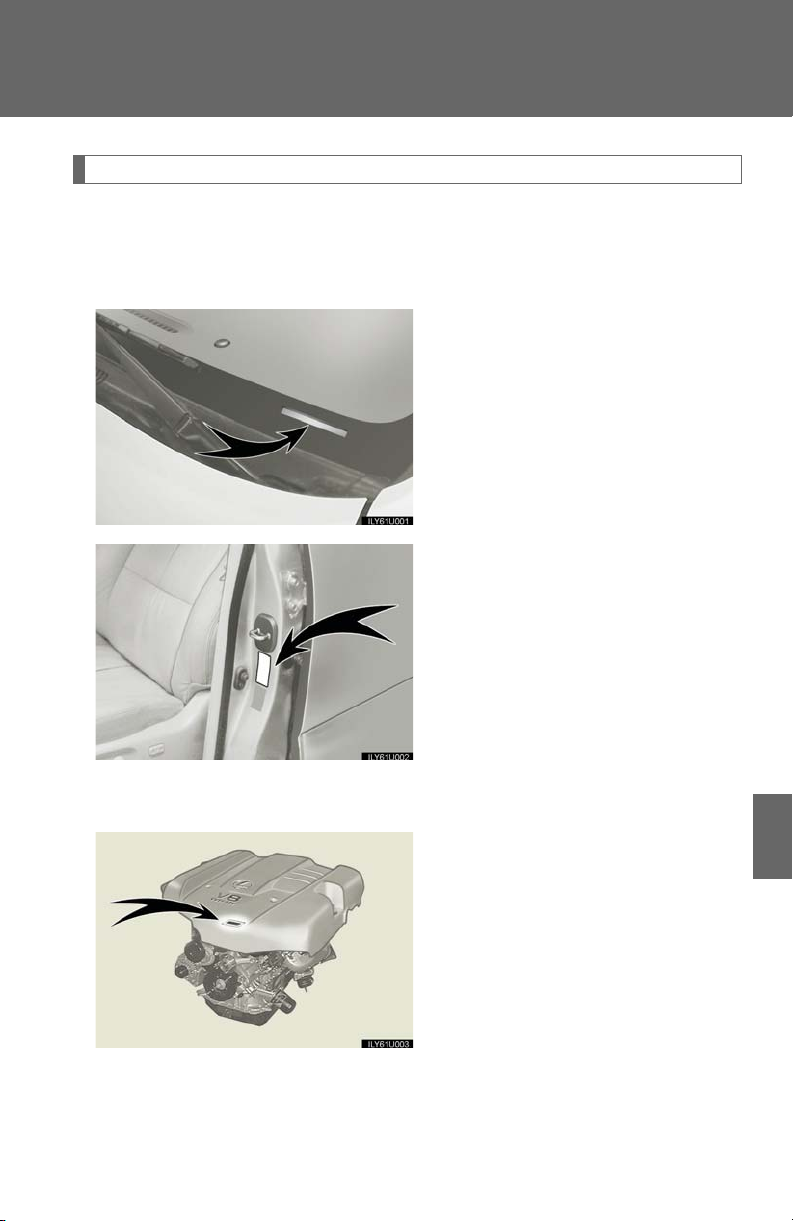
6-1. Specifications
Vehicle identification
The vehicle identification number (VIN) is the legal identifier for your vehicle. This is the primary identification number for your Lexus. It is used in registering the ownership of your vehicle.
This number is stamped on the top
left of the instrument panel.
This number is also on the Certification Label.
n Engine number
The engine number is stamped on
the engine block as shown.
379
6
Vehicle specifications
Page 52

6-1. Specifications
Engine
Model 2UZ-FE
Ty p e 8-cylinder V type, 4-cycle, gasoline
Bore and stroke 3.70 × 3.31 in. (94.0 × 84.0 mm)
Displacement 284.5 cu.in. (4664 cm3)
Drive belt tension Automatic adjustment
Fuel
Fuel type Premium unleaded gasoline only
Octane rating 91 (Research Octane Number 96) or higher
Fuel tank capacity 23 gal. (87 L, 19.1 Imp.gal)
380
Page 53

Lubrication system
Oil capacity
(drain and refill)
6-1. Specifications
with filter
without filter
Oil grade ILSAC multigrade engine oil
Recommended oil
viscosity
6.5 qt. (6.2 L, 5.5 Imp.qt.)
6.0 qt. (5.7 L, 5.0 Imp.qt.)
Use Lexus approved “Toyota Genuine Motor Oil” or
equivalent to satisfy the above grade and viscosity.
Outside temperature
*:5W-30 is an oil that provides optimal levels of fuel efficiency.
Oil viscosity:
l The 5W portion of the oil viscosity rating indicates the characteristic of
the oil which allows cold startability. Oils with a lower value before the W
allow for easier starting of the engine in cold weather.
6
l The 30 in 5W-30 indicates the oil viscosity when the oil is as its operating
temperature. An oil with a higher viscosity may be better suited if the
vehicle is operated at high speeds, or under extreme load conditions.
381
Vehicle specifications
Page 54

6-1. Specifications
Cooling system
Capacity 13.6 qt. (12.9 L, 11.4 Imp.qt.)
Use either of the following:
• “Toyota Super Long Life Coolant”
Coolant type
• Similar high-quality ethylene glycol-based non-silicate, non-amine, non-nitrite, and non-borate coolant with long-life hybrid organic acid technology
Do not use plain water alone.
Ignition system
Spark plug
Make DENSO
NGK
SK20R11
IFR6A11
Gap 0.043 in. (1.1 mm)
NOTICE
n Iridium-tipped spark plugs
Use only iridium-tipped spark plugs. Do not adjust the gap when tuning the engine.
382
Page 55
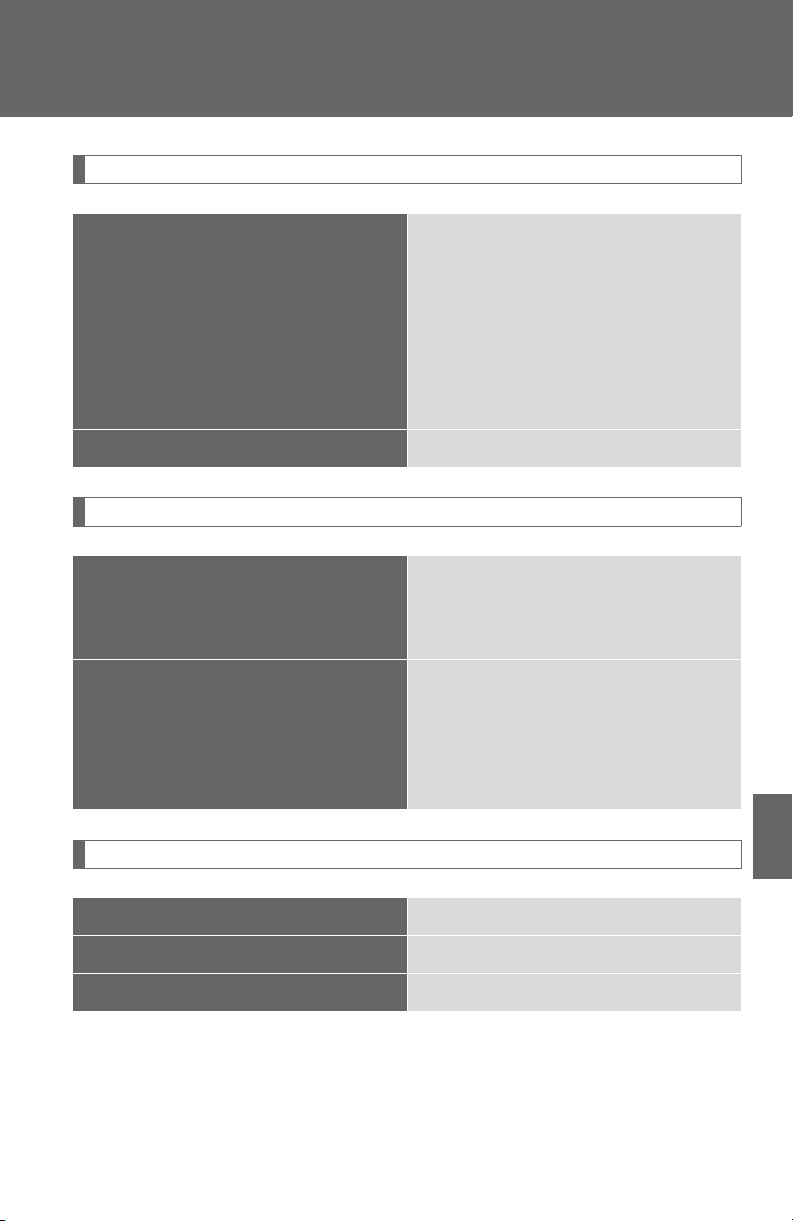
Electrical system
Battery
6-1. Specifications
Open voltage at
68°F (20°C):
12.6 ⎯ 12.8V Fully charged
12.2 ⎯ 12.4V Half charged
11.8 ⎯ 12.0V Discharged
(Voltage is checked 20 minutes after
the key is removed with all the lights
turned off.)
Charging rates 5A max.
Differential
Oil capacity
Front
Rear
1.5 qt. (1.4 L, 1.2 Imp.qt.)
3.3 qt. (3.1 L, 2.7 Imp.qt.)
Hypoid gear oil API GL-5
Above 0°F (-18°C): SAE 90 or
Oil type and viscosity
SAE 85W-90
Below 0°F (-18°C): SAE 80W or
SAE 80W-90
Tra n s f e r
Oil capacity 1.5 qt. (1.4 L, 1.2 Imp.qt.)
6
Vehicle specifications
Oil type Hypoid gear oil API GL-5
Recommended oil viscosity SAE 75W-90
383
Page 56

6-1. Specifications
Tra n s m i ss i o n
Fluid capacity
Drain and refill
3.2 qt. (3.0 L, 2.6 lmp.qt.)
Fluid type To yo ta Ge nu ine AT F W S
NOTICE
n Transmission fluid type
Using transmission fluid other than “Toyota Genuine ATF WS” may cause deterioration in shift quality, locking up of your transmission accompanied by vibration, and
ultimately damage the transmission of your vehicle.
Brakes
Pedal clearanc e *
1
2.0 in. (52 mm) Min.
Pedal free play 0.04 ⎯ 0.24 in. (1.0 ⎯ 6.0 mm)
Brake pad wear limit 0.04 in. (1.0 mm)
Parking brake adjustment
*2
5 ⎯ 7 clicks
Parking brake lining wear limit 0.04 in. (1.0 mm)
Fluid type SAE J1703 or FMVSS No. 116 DOT 3
1
*
: Minimum pedal clearance when depressed with a force of 490 N (50 kgf, 110
lbf) while the engine is running.
2
*
: Parking brake adjustment when depressed with a force of 196 N (20 kgf, 44
lbf).
384
Page 57

Chassis lubrication
Propeller shafts
6-1. Specifications
Spiders
Slide yoke
Lithium base chassis grease, NLGI No.2
Molybdenum-disulfide lithium base chassis
grease,
NLGI No.2 or lithium base chassis grease,
NLGI No.2
Steering
Free play Less than 1.2 in. (30 mm)
Power steering fluid
Automatic transmission fluid DEXRON® II
or III
Tires and wheels
Tire si ze P265/65R17 110S
Driving under normal conditions
Tire inflation pressure
(Recommended cold tire inflation
pressure)
32 psi (220 kPa, 2.2
Driving at high speeds above 100 mph (160
km/h) (in countries where such speeds are permitted by law)
Add 9 psi (60 kPa, 0.6 kgf/cm
front tires and rear tires. Never exceed the
maximum cold tire inflation pressure indicated
on the tire sidewall.
kgf/cm
2
or bar)
2
or bar) to the
6
Vehicle specifications
Wheel size 17 × 7 1/2 JJ
Wheel nut torque 83 ft•lbf (112 N•m, 11.5 kgf•m)
385
Page 58

6-1. Specifications
Light bulbs
Headlights (low beam) ⎯ 55 A
Headlights (high beam) 9005 60 B
Front turn signal lights 4157NAK 27/8 D
Parking lights 168 5 C
Fog lights ⎯ 55 E
Front side marker light 168 5 C
Exterior
Stop/tail lights 7443 21 /5 C
Light Bulbs Bulb No. W Ty p e
Stop/tail and rear side marker
lights
Rear turn signal lights 74 4 0 21 C
Back-up lights 74 4 0 21 C
Running board lights 194 3.8 C
License plate lights 168 5 C
Vanity lights ⎯ 2 F
Pers onal li ghts ⎯ 8 G
Interior
Interior lights ⎯ 8 F
Door courtesy lights ⎯ 3.8 G
Glove box light ⎯ 1.2 C
A: H11 halogen bulbs B: HB3 halogen bulbs C: Wedge base bulbs (clear) D: Wedge base bulbs (amber) E: H3 halogen bulbs F: Double end bulbs G: Single end bulbs
7443 21 /5 C
386
Page 59

6-1. Specifications
Fuel information
Your vehicle must use only unleaded gasoline. Premium unleaded gasoline with an Octane Rating of 91 (Research Octane Number 96) or higher required for optimum engine performance.
At minimum, the gasoline you use should meet the specifications of ASTM D4814 in the U.S.A. and CGSB3.5-M93 in Canada.
n Fuel tank opening for unleaded gasoline
To help prevent incorrect fueling, your Lexus has a fuel tank opening that only accommodates the special nozzle on unleaded fuel pumps.
n If premium gasoline is not available
If this premium fuel is not available, you may use unleaded gasoline with an octane rating as low as 87 (Research Octane Number 91).
n If your engine knocks
l Consult your Lexus dealer.
l You may occasionally notice light knocking for a short time while accelerating
or driving uphill. This is normal and there is no need for concern.
n Gasoline quality
In very few cases, driveability problems may be caused by the brand of gasoline you are using. If driveability problems persist, try changing the brand of gasoline. If this does not correct the problem, consult your Lexus dealer.
387
6
Vehicle specifications
Page 60

6-1. Specifications
n Gasoline quality standards
l Automotive manufacturers in the US, Europe and Japan have developed a
specification for fuel quality called World-Wide Fuel Charter (WWFC) that is
expected to be applied worldwide.
l The WWFC consists of four categories that are based on required emission
levels. In the US, category 3 or 4 has been adopted.
l The WWFC improves air quality by lowering emissions in vehicle fleets, and
customer satisfaction through better performance.
n Lexus recommends the use of gasoline containing detergent additives
l Lexus recommends the use of gasoline that contains detergent additives to
avoid build-up of engine deposits.
l All gasoline sold in the US contains detergent additives to clean and/or keep
clean intake systems.
n Lexus recommends the use of cleaner burning gasoline
Cleaner burning gasoline, including reformulated gasoline that contains oxygenates such as ethanol or MTBE (Methyl Tertiary Butyl Ether) is available in many
areas.
Lexus recommends the use of cleaner burning gasoline and appropriately blended
reformulated gasoline. These types of gasoline provide excellent vehicle performance, reduce vehicle emissions and improve air quality.
n Lexus does not recommend blended gasoline
l Lexus allows the use of oxygenate blended gasoline where the oxygenate con-
tent is up to 10% ethanol or 15% MTBE.
l If you use gasohol in your Lexus, be sure that it has an octane rating no lower
than 87.
l Lexus DOES NOT recommend the use of gasoline containing methanol.
n Lexus does not recommend gasoline containing MMT
Some gasoline contains octane enhancing additive called MMT (Methylcy clopentadienyl Manganese Tricarbonyl).
Lexus DOES NOT recommend the use of gasoline that contains MMT. If fuel containing MMT is used, your emission control system may be adversely affected.
The malfunction indicator lamp on the instrument cluster may come on. If this happens, contact your Lexus dealer for service.
388
Page 61

6-1. Specifications
NOTICE
n Notice on gasoline quality
l Do not use leaded gasoline.
Leaded gasoline can cause damage to your vehicle’s three-way catalytic converters causing the emission control system to malfunction.
l Do not use gasohol other than that stated here.
Other gasohol may cause fuel system damage or vehicle performance problems.
l Use of unleaded gasoline with an octane rating lower than 91 may result in engine
knocking.
Persistent knocking can lead to engine damage and should be corrected by refueling with higher octane unleaded gasoline.
n Fuel-related poor driveability
If after using a different type of fuel, poor driveability is encountered (poor hot starting, vaporization, engine knocking, etc.), discontinue the use of that type of fuel.
n When refueling with gasohole
Take care not to spill gasohol. It can damage your vehicle's paint.
389
6
Vehicle specifications
Page 62

6-1. Specifications
Tire information
Ty p ic a l t i re s ym b ol s
Tire size (→P. 392)
DOT and Tire Identification Number (TIN) (→P. 391)
Location of tread wear indicators (→P. 3 02 )
Tire ply composition and materials
Plies are layers of rubber-coated parallel cords. Cords are the strands which form the plies in a tire.
Radial tires or bias-ply tires
A radial tire has RADIAL on the sidewall. A tire not marked RADIAL is a bias-ply tire.
TUBELESS or TUBE TYPE
A tubeless tire does not have a tube and air is directly filled in the tire. A
tube type tire has a tube inside the tire and the tube maintains the air pressure.
Load limit at maximum cold tire inflation pressure (→P. 395)
Maximum cold tire inflation pressure (→P. 395)
This means the pressure to which a tire may be inflated.
Uniform tire quality grading
For details, see “Uniform Tire Quality Grading” that follows.
390
Page 63

6-1. Specifications
Summer tire or all season tire (→P. 305)
An all season tire has “M+S” on the sidewall. A tire not marked “M+S” is a summer tire.
Typical DOT and tire identification number (TIN)
DOT symbol
*
Tire Identification Number (TIN)
Tire manufacturer's identifica-
tion mark
Tire size code
Manufacturer's optional tire
type code (3 or 4 letters)
Manufacturing week
Manufacturing year
*: The DOT symbol certifies that
the tire conforms to applicable
Federal Motor Vehicle Safety
Standards.
6
Vehicle specifications
391
Page 64
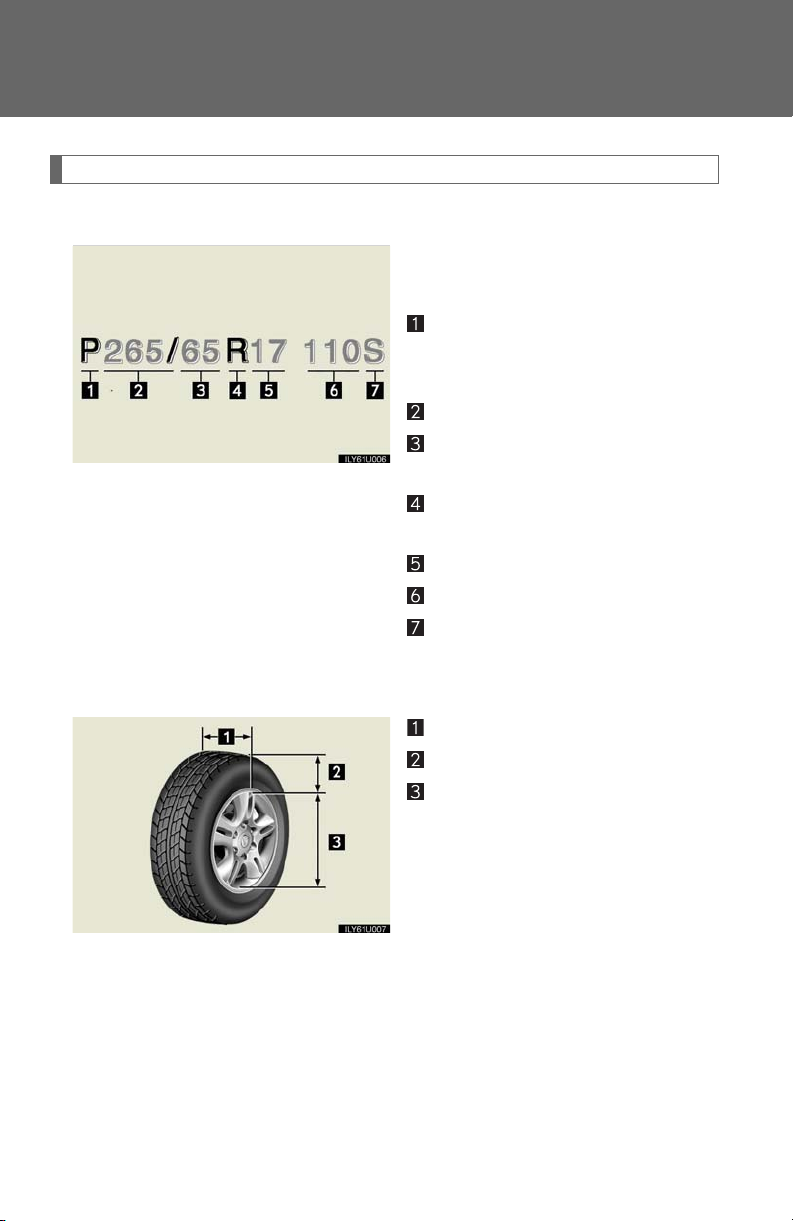
6-1. Specifications
Tire size
n Typical tire size information
The illustration indicates typical
tire size.
Tire us e
(P = Passenger car,
T = Temporary use)
Section width (millimeters)
Aspect ratio
(tire height to section width)
Tire construction code
(R = Radial, D = Diagonal)
Wheel diameter (inches)
Load index (2 or 3 digits)
Speed symbol
(alphabet with one letter)
n Tire dimensions
392
Section width
Tire he igh t
Wheel diameter
Page 65

Tire section names
Uniform Tire Quality Grading
6-1. Specifications
Bead
Sidewall
Shoulder
Tr e a d
Belt
Inner liner
Reinforcing rubber
Carcass
Rim lines
Bead wires
Chafer
This information has been prepared in accordance with regulations
issued by the National Highway Traffic Safety Administration of the
U.S.A. Department of Transportation.
It provides the purchasers and/or prospective purchasers of Lexus vehicles with information on uniform tire quality grading.
Your Lexus dealer will help answer any questions you may have as you read this information.
n DOT quality grades
All passenger vehicle tires must conform to Federal Safety Requirements in addition to these grades. Quality grades can be found where
applicable on the tire sidewall between tread shoulder and maximum
section width.
For example: Treadwear 200 Traction AA Temperature A
393
6
Vehicle specifications
Page 66

6-1. Specifications
n Treadwear
The treadwear grade is a comparative rating based on the wear rate of
the tire when tested under controlled conditions on a specified government test course.
For example, a tire graded 150 would wear one and a half (1 - 1/2) times as
well on the government course as a tire graded 100.
The relative performance of tires depends upon the actual conditions of
their use, however, and may depart significantly from the norm due to variations in driving habits, service practices and differences in road characteristics and climate.
n Traction AA, A, B, C
The traction grades, from highest to lowest, are AA, A, B and C, and they represent the tire's ability to stop on wet pavement as measured under controlled conditions on specified government test surfaces of asphalt and concrete.
A tire marked C may have poor traction performance.
Warning: The traction grade assigned to this tire is based on braking
(straight ahead) traction tests and does not include cornering (turning) traction.
n Temperature A, B, C
The temperature grades are A (the highest), B, and C, representing the tire's resistance to the generation of heat and its ability to dissipate heat when tested under controlled conditions on a specified indoor laboratory test wheel.
Sustained high temperature can cause the material of the tire to degenerate
and reduce tire life, and excessive temperature can lead to sudden tire failure.
The grade C corresponds to a level of performance which all passenger car tires must meet under the Federal Motor Vehicle Safety Standard No. 109.
Grades B and A represent higher levels of performance on the laboratory test wheel than the minimum required by law.
394
Page 67

6-1. Specifications
Warning: The temperature grades for this tire are established for a tire that
is properly inflated and not overloaded.
Excessive speed, underinflation, or excessive loading, either separately or in
combination, can cause heat buildup and possible tire failure.
Glossary of tire terminology
Tire related term Meaning
The combined weight (in excess of those standard
items which may be replaced) of automatic transmis-
Accessory weight
sion, power steering, power brakes, power windows,
power seats, radio and heater, to the extent that these
items are available as factory-installed equipment
(whether installed or not)
Cold tire inflation pressure
Curb weight
Maximum inflation pressure
Maximum loaded vehicle
weight
Normal occupant weight
Tire pressure when the vehicle has been parked for
three hours or more, or has not been driven more
than 1 mile or 1.5 km under that condition
The weight of a motor vehicle with standard equipment, including the maximum capacity of fuel, oil and
coolant, and if so equipped, air conditioning and
additional weight optional engine
The maximum cold inflated pressure to which a tire
may be inflated, shown on the sidewall of the tire
The sum of:
(a) Curb weight
(b) Accessory weight
(c) Vehicle capacity weight
(d) Production options weight
150 lb. (68 kg) times the number of occupants specified in the second column of Table 1
* that follows
6
Vehicle specifications
395
Page 68

6-1. Specifications
Tire related term Meaning
The combined weight of installed regular production
options weighing over 5 lb. (2.3 kg) in excess of the
Production options
weight
standard items which they replace, not previously
considered in curb weight or accessory weight,
including heavy duty brakes, ride levelers, roof rack,
heavy duty battery, and special trim
Vehicle capacity weight
(Total load capacity)
The rated cargo and luggage load plus 150 lb. (68
kg) times the vehicle's designated seating capacity
(a) The sidewall that contains a whitewall, bears
white lettering, or bears manufacturer, brand,
and/or model name molding that is higher or
Intended outboard sidewall
deeper than the same molding on the other side-
wall of the tire, or
(b) The outward facing sidewall of asymmetrical tire
that has a particular side that must always face
outward when mounted on a vehicle
Occupant distribution
Recommended inflation
pressure
Rim
Rim diameter
(Wheel diameter)
Distribution of occupants in a vehicle as specified in
the third column of Table 1
Cold tire inflation pressure recommended by a manufacturer.
A metal support for a tire or a tire and tube assembly
upon which the tire beads are seated
Nominal diameter of the bead seat
Rim size designation Rim diameter and width
* below
Rim type designation
The industry manufacturer's designation for a rim by
style or code
Rim width Nominal distance between rim flanges
396
Page 69

Tire related term Meaning
6-1. Specifications
Vehicle maximum load on
the tire
Vehicle normal load on
the tire
Weat he r s id e
The load on an individual tire that is determined by
distributing to each axle its share of the maximum
loaded vehicle weight, and dividing by two
The load on an individual tire that is determined by
distributing to each axle its share of curb weight,
accessory weight, and normal occupant weight (distributed in accordance with Table 1
dividing it by two
The surface area of the rim not covered by the
inflated tire
* below), and
*:Table 1 ⎯ Occupant loading and distribution for vehicle normal load for
various designated seating capacities
Designated seating
capacity, Number of
occupants
2 through 4 2 2 in front
5 through 10 3 2 in front, 1 in second seat
Vehicle normal load,
Number of occupants
Occupant distribution in
a normally loaded vehicle
397
6
Vehicle specifications
Page 70

Vehicle specifications
6
6-1. Specifications ......................... 378
Maintenance data..................... 378
Fuel information......................... 387
Tire information.......................... 390
6-2. Customization........................ 398
Customizable features ........... 398
6-3. Initialization.............................. 401
Items to initialize......................... 401
377
Page 71
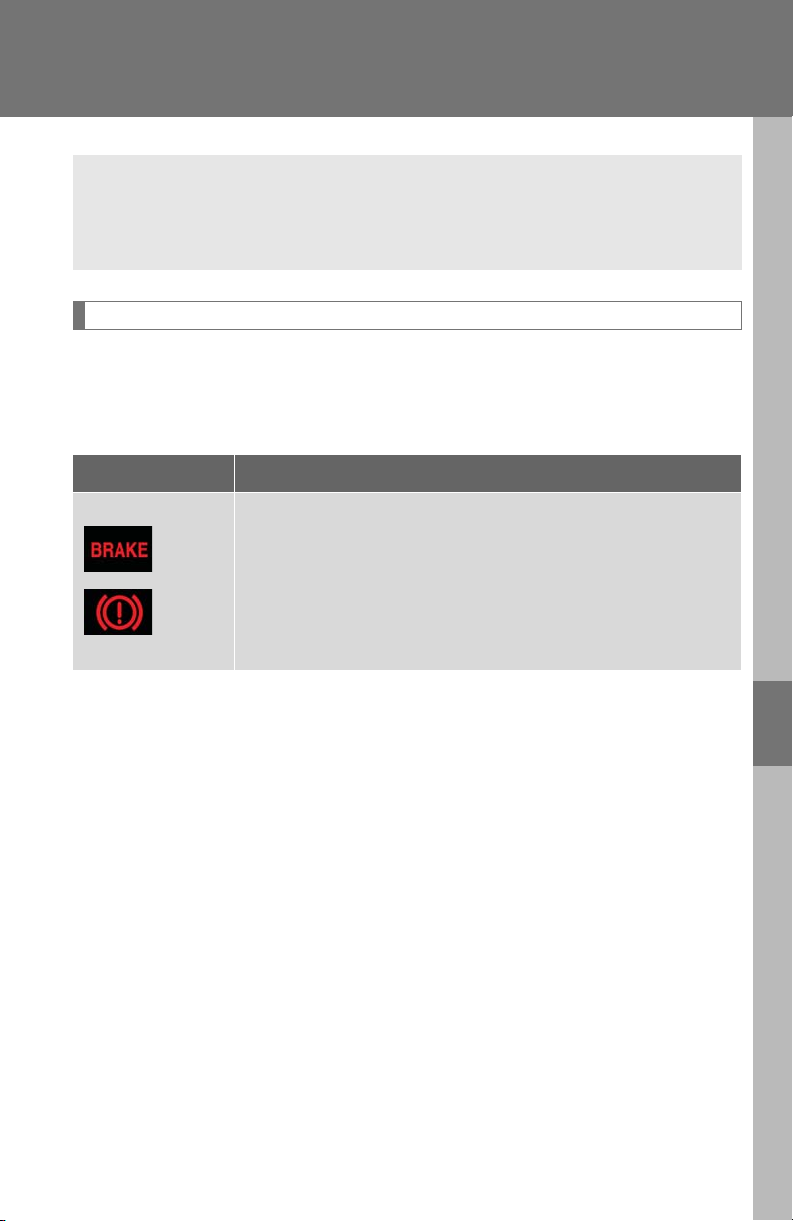
5-2. Steps to take in an emergency
If a warning light turns on or a warning buzzer sounds...
Calmly perform the following actions if any of the warning lights turn on or
flash. If a light turns on or flashes, but then turns off, this does not necessarily indicate a malfunction in the system.
Stop the vehicle immediately. Continuing to drive the vehicle may be dangerous.
The following warning indicates a possible problem in the brake system. Immediately stop the vehicle in a safe place and contact your Lexus dealer.
Warning light Warning light/Details
Brake system warning light
(U.S.A.)
(Canada)
• Low brake fluid
• Malfunction in the brake system
This light also comes on when the parking brake is not
released. If the light turns off after the parking brake is fully
released, the system is operating normally.
347
5
When trouble arises
Page 72

5-2. Steps to take in an emergency
Stop the vehicle immediately.
The following warning indicates the possibility of damage to the vehicle that may lead to an accident. Immediately stop the vehicle in a safe place and contact your Lexus dealer.
Warning light Warning light/Details
Charging system warning light
Indicates a malfunction in the vehicle’s charging system
while the engine is running.
Low engine oil pressure warning light
Indicates an abnormal level of engine oil pressure.
This warning light may turn on if the level of engine oil
declines. The light should turn off after checking the oil and
adding oil if necessary.
Have the vehicle inspected by your Lexus dealer immediately.
Failing to investigate the cause of the following warnings may lead to the system operating abnormally and possibly cause an accident. Have the vehicle inspected by your Lexus dealer immediately.
Warning light Warning light/Details
Malfunction indicator lamp
Malfunction in:
• The electronic engine control system;
• The electronic throttle control system; or
• The electronic automatic transmission control system.
SRS warning light
Malfunction in:
• The SRS airbag system;
• The front passenger occupant classification system; or
• The seat belt pretensioner system.
348
(U.S.A.)
(Canada)
Page 73
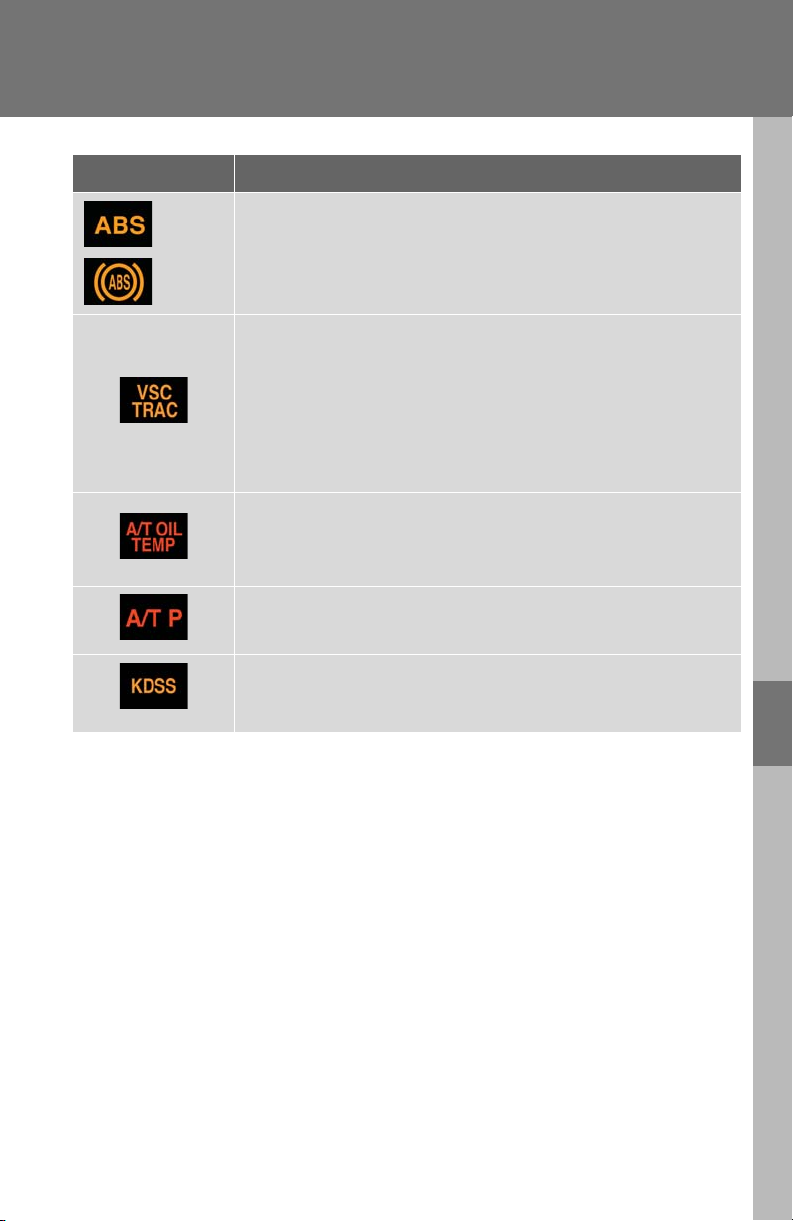
5-2. Steps to take in an emergency
Warning light Warning light/Details
(U.S.A.)
(Canada)
(if equipped)
ABS warning light
Malfunction in:
•The ABS; or
• The brake assist system.
VSC/TRAC warning light
Malfunction in:
•The VSC;
• The active traction control system;
• The downhill assist control system; or
• The hill-start assist control system.
Automatic transmission fluid temperature warning light
Indicates that the automatic transmission fluid temperature
is too high.
Unengaged “Park” warning light
Malfunction in the transmission “Park” mechanism.
Kinetic dynamic suspension system warning light
Malfunction in the kinetic dynamic suspension system.
5
When trouble arises
349
Page 74

5-2. Steps to take in an emergency
Have the malfunction repaired immediately.
After taking the specified steps to correct the suspected problem, check that the warning light turns off.
Warning light Warning light/Details Correction procedure
Open door warning light
A door or a back door is not
fully closed.
Low fuel level warning light
Remaining fuel
(Approximately 2.9 gal. [11 L,
2.4 Imp.gal.] or less)
Low washer fluid warning
light
Low level of washer fluid.
Engine oil replacement
reminder light
Illuminates for about 3 seconds and then flashes for
about 12 seconds: The engine
oil is scheduled to be changed.
Comes on and remains on:
The engine oil should be
changed.
Check that all doors and the
back door are closed.
Refuel the vehicle.
Fill the tank.
Check the engine oil, and
change if necessary.
Check and change the engine
oil.
350
Page 75
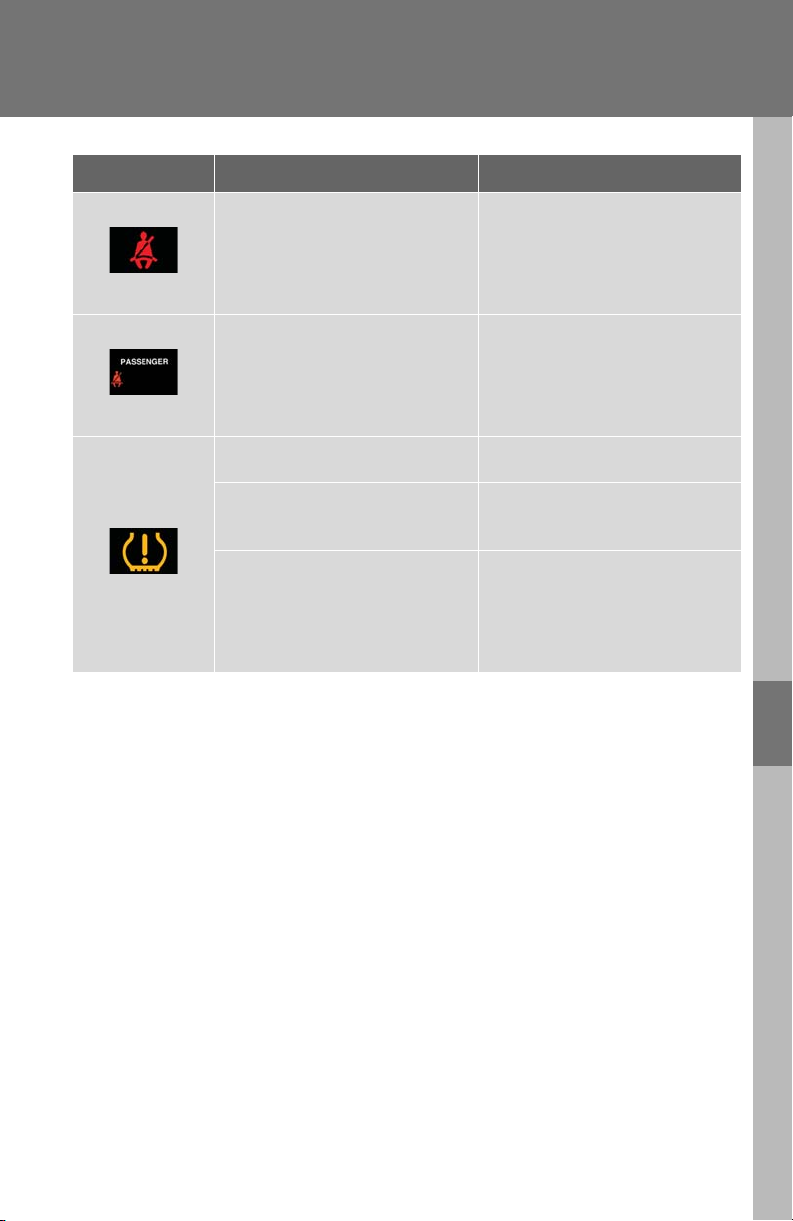
5-2. Steps to take in an emergency
Warning light Warning light/Details Correction procedure
Driver’s seat belt reminder
light (warning buzzer)
Warns the driver to fasten
his/her seat belt.
Front passenger’s seat belt
reminder light
Warns the front passenger to
fasten his/her seat belt.
Tire pressure warning light
*
Fasten the seat belt.
Fasten the seat belt.
When the light comes on:
Low tire inflation pressure.
When the light stays on after
blinking for 1 minute:
Malfunction in the tire pressure warning system.
Adjust the tire inflation pressure.
Have the system checked by
your Lexus dealer.
*: Driver’s seat belt reminder buzzer:
The driver’s seat belts reminder sounds to alert the driver that his or her seat
belt is not fastened. Once the ignition key is turned to the “ON” or “START”
position, the reminder light flashes and a buzzer sounds if the driver's seat belt
is not fastened. Unless the driver fastens the belt, the light continues flashing,
however the buzzer stops after about 4 to 8 seconds.
5
When trouble arises
351
Page 76

5-2. Steps to take in an emergency
n If the malfunction indicator lamp comes on while driving
First check the following:
l Is your vehicle low on gas?
If it is, refuel the vehicle immediately.
l Is the fuel tank cap loose?
If it is, tighten it securely.
The light will go off after taking several driving trips. If the light does not go off even after several trips, contact your Lexus dealer as soon as possible.
n Front passenger detection sensor and passenger seat belt reminder
l If luggage is placed on the front passenger seat, the front passenger detection
sensor may cause the warning light to flash, even if a passenger is not sitting in
the seat.
l If a cushion is placed on the seat, the sensor may not detect a passenger, and the
warning light may not operate properly.
n SRS warning light
This warning light system monitors the following:
l The airbag sensor assembly
l Front airbag sensors
l The curtain shield airbag sensors
l The side and curtain shield airbag sensors
l The occupant detection system (ECU and sensors)
l “AIRBAG ON” and “AIRBAG OFF” indicator lights
l The seat belt buckle switches
l The driver’s seat position sensor
l The driver’s seat belt buckle switch
l Front passenger’s seat belt buckle switch
l The inflators
l The warning light
l The interconnecting wiring and power sources
352
Page 77

5-2. Steps to take in an emergency
n When the tire pressure warning light comes on
Check the tire inflation pressure and adjust to the appropriate level.
n The tire pressure warning light may turn on due to natural causes
The tire pressure warning light may turn on due to natural causes such as natural air
leaks or tire inflation pressure changes caused by temperature. In this case, adjusting the tire inflation pressure will turn off the warning light.
n When a tire is replaced with a spare tire
The spare tire is also equipped with the tire pressure warning valve and transmitter.
The tire pressure warning light will turn on if the tire inflation pressure of the spare
tire is low. If a tire goes flat, even though the flat tire is replaced with the spare tire,
the warning light does not turn off. Replace the spare tire with the repaired tire and
adjust the proper tire inflation pressure. The warning light will turn off after a few
minutes.
n If the tire pressure warning system is inoperative
The tire pressure warning system may become inoperative in the following conditions:
(When the condition becomes normal, the system will work properly.)
l If tires not equipped with tire pressure warning valves and transmitters are used.
l If the ID code on the tire pressure warning valves and transmitters is not regis-
tered.
l If electronic devices or facilities using similar radio wave frequencies are nearby.
l If a radio set at similar frequencies is in use in the vehicle.
l If a window tint that affects the radio wave signals is installed.
l If the tire pressure warning select switch is set to a different tire setting.
l If there is a lot of snow or ice on the vehicle, in particular around the wheels or
wheel housings.
l If non-genuine Lexus wheels are used.
l If tire chains are used.
l If the tire inflation pressure is 73 psi (500 kPa, 5.1 kgf/cm
l If the tire is in a location subject to poor radio wave signal reception.
2
or bar) or higher.
5
When trouble arises
353
Page 78

5-2. Steps to take in an emergency
n If the tire pressure warning light comes on after blinking for 1 minute frequently
If the tire pressure warning light comes on after blinking for 1 minute frequently when the ignition switch is turned to the “ON” position, have it checked by your Lexus dealer.
n After changing the engine oil (U.S.A. only)
Make sure to reset the oil maintenance data. (→P. 292)
CAUTIO N
n Maintenance of the tires
Each tire, including the spare (if provided), should be checked monthly when cold
and inflated to the inflation pressure recommended by the vehicle manufacturer on
the vehicle placard or tire inflation pressure label (tire and load information label).
(If your vehicle has tires of a different size than the size indicated on the vehicle
placard or tire inflation pressure label [tire and load information label], you should
determine the proper tire inflation pressure for those tires.)
As an added safety feature, your vehicle has been equipped with a tire pressure
monitoring system (TPMS-tire pressure warning system) that illuminates a low tire
pressure telltale (tire pressure warning light) when one or more of your tires is significantly under-inflated. Accordingly, when the low tire pressure telltale (tire pressure warning light) illuminates, you should stop and check your tires as soon as
possible, and inflate them to the proper pressure. Driving on a significantly underinflated tire causes the tire to overheat and can lead to tire failure. Under-inflation
also reduces fuel efficiency and tire tread life, and may affect the vehicle's handling
and stopping ability.
Please note that the TPMS (tire pressure warning system) is not a substitute for
proper tire maintenance, and it is the driver's responsibility to maintain correct tire
pressure, even if under-inflation has not reached the level to trigger illumination of
the TPMS low tire pressure telltale (tire pressure warning light).
354
Page 79

5-2. Steps to take in an emergency
CAUTIO N
n If the tire pressure warning light comes on
Be sure to observe the following precautions. Failure to do so could cause loss of vehicle control and result in death or serious injury.
l Stop your vehicle in a safe place as soon as possible. Adjust the tire inflation pres-
sure immediately.
l If the tire pressure warning light comes on even after tire inflation pressure adjust-
ment, it is probable that you have a flat tire. Check the tires. If the tire is flat,
change to the spare tire and have the flat tire repaired by the nearest Lexus
dealer.
l Avoid abrupt maneuvering and braking. If the vehicle tires deteriorate, you could
lose control of the steering wheel or the brakes.
n If a blowout or sudden air leakage should occur
The tire pressure warning system may not activate immediately.
NOTICE
n Precaution when installing a different tire
When a tire of a different specification or maker is installed, the tire pressure warning system may not operate properly.
5
When trouble arises
355
Page 80

5-2. Steps to take in an emergency
If you have a flat tire
Remove the flat tire and replace it with the spare provided.
n Before jacking up the vehicle
l Stop the vehicle on a hard, flat surface.
l Set the parking brake.
l Shift the shift lever to “P”. l Turn off the rear height control air suspension. (→P. 123)
l Stop the engine.
l Turn on the emergency flashers.
n Location of the spare tire, jack and tools
Jack
Spare tire
Jack handle and extensions
To o l s
Wheel nut
wrench
356
Page 81

Taking out the jack and tools
Jack
To o l s
5-2. Steps to take in an emergency
Remove the jack compartment
cover and take out the jack.
Remove the tool tray compartment cover and take out the tool
tray.
Jack handle
5
When trouble arises
Assemble the jack handle extension as shown. Be sure to tighten
each bolt securely.
357
Page 82

5-2. Steps to take in an emergency
Taking out the spare tire
STEP 1
STEP 2
STEP 3
Remove the spare tire carrier lid
using a flathead screwdriver.
Insert the jack handle extension
into the lowering socket.
Place a rag under the jack handle
extension to protect the bumper.
Lower
Raise
Lower the spare tire completely to
the ground.
Vehicles with kinetic dynamic suspension: If the spare tire becomes caught on the suspension components, raise the tire, pull it towards the rear of the vehicle, and begin lowering it again.
358
Page 83

5-2. Steps to take in an emergency
STEP 4
Replacing a flat tire
STEP 1
Flat tire Wheel chock position
Pull out the spare tire and remove
the holding bracket.
Chock the tires.
5
Front
Rear
Left-hand side Behind the rear right-hand side tire
Right-hand side Behind the rear left-hand side tire
Left-hand side In front of the front right-hand side tire
Right-hand side In front of the front left-hand side tire
When trouble arises
359
Page 84

5-2. Steps to take in an emergency
STEP 2
STEP 3
STEP 4
Remove the wheel ornament using
the wheel nut wrench as shown.
Slightly loosen the wheel nuts (one
turn).
Turn the tire jack portion “A” by
hand until the head of the jack is in
contact with the appropriate jack
point.
360
Front (vehicles without kinetic
dynamic suspension)
Front (vehicles with kinetic
dynamic suspension)
Rear
Page 85
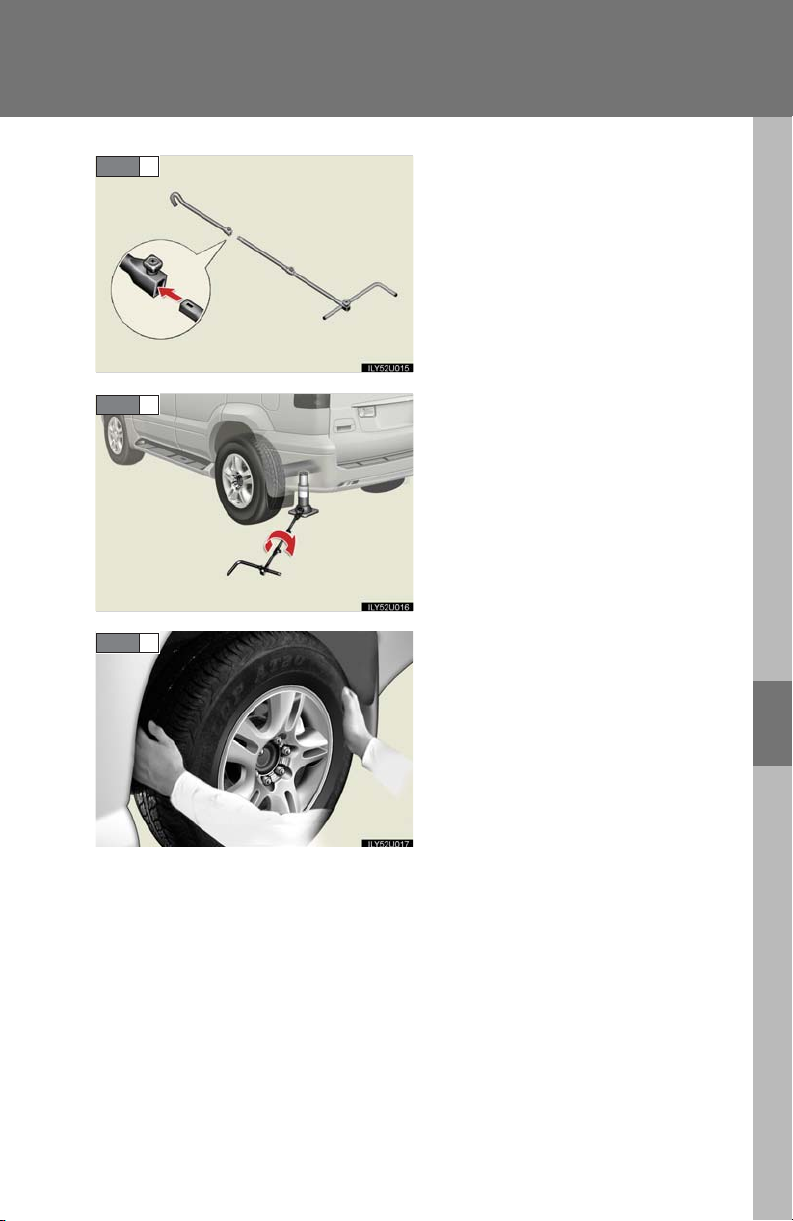
5-2. Steps to take in an emergency
STEP 5
STEP 6
STEP 7
Attach the hooked jack handle end
to the jack handle extension as
shown.
Raise the vehicle until the tire is
slightly raised off the ground.
Remove all the wheel nuts and the
tire.
When resting the tire on the
ground, place the tire so that the
wheel design faces up to avoid
scratching the wheel surface.
5
When trouble arises
361
Page 86

5-2. Steps to take in an emergency
Installing the spare tire
STEP 1
STEP 2
STEP 3
Wa sh e r
Disc wheel
Wheel nut
Remove any dirt or foreign matter
from the wheel contact surface.
If foreign matter is on the wheel
contact surface, the wheel nuts
may loosen while the vehicle is in
motion, and the tire may come off
the vehicle.
Install the spare tire and loosely
tighten each nut by hand to
approximately the same amount.
Tighten the wheel nuts until the
tapered portion comes into loose
contact with the disc wheel sheet.
Lower the vehicle.
362
Page 87
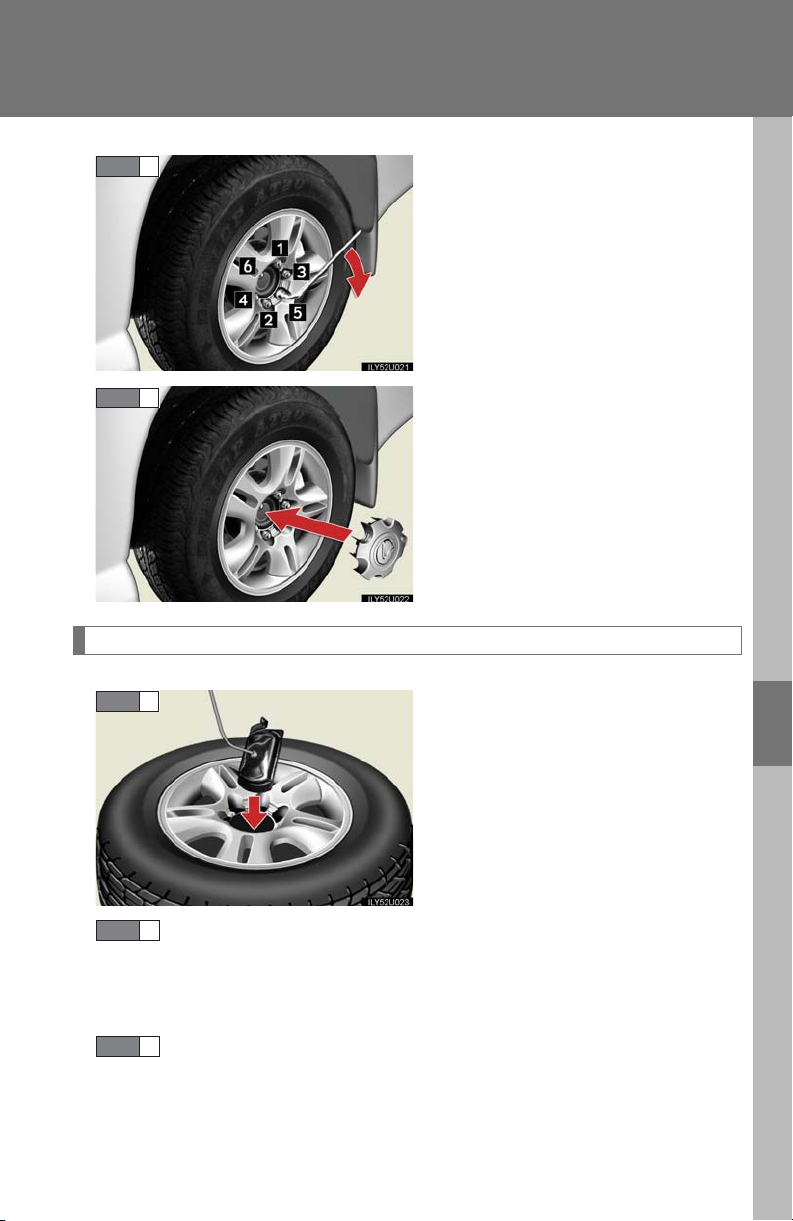
5-2. Steps to take in an emergency
STEP 4
Firmly tighten each nut two or
three times in the order shown in
the illustration.
STEP 5
Reinstall the wheel ornament.
Stowing the flat/spare tire, jack and tools
STEP 1
Lay down the tire with the outer
side facing up, and install the holding bracket.
Tightening torque:
83 ft•lbf (112 N•m, 11.5 kgf•m)
5
When trouble arises
STEP 5
STEP 2
STEP 5
STEP 3
Raise the tire. Vehicles with kinetic dynamic suspension: Pull the tire towards the rear of the vehicle when raising. After raising, visually check that the tire is not interfering with suspension components.
Stow the tools and jack securely, and replace all covers.
363
Page 88

5-2. Steps to take in an emergency
CAUTIO N
n Using the tire jack
Improper use of the tire jack may lead to death or injuries due to the vehicle suddenly falling off the jack.
l Do not use the tire jack for any purpose other than replacing tires or installing and
removing tire chains.
l Only use the tire jack that comes with this vehicle for replacing a flat tire.
Do not use it on other vehicles, and do not use other tire jacks for replacing tires
on this vehicle.
l Always check that the tire jack is securely set to the jack point.
l Be sure to turn off the rear height control air suspension and stop the engine.
l Do not raise the vehicle while someone is in it.
l When raising the vehicle, do not put an object on or under the jack.
l Do not raise the vehicle to a height greater than that required to replace the tire.
l Use a jack stand if it is necessary to get under the vehicle.
l Do not put any part of your body under the vehicle supported by a jack.
l Do not start or run the engine while your vehicle is supported by the jack.
Take particular care when lowering the vehicle to ensure that no one working on or near the vehicle may be injured.
n Using the jack handle
Tighten all the jack handle bolts securely using a Phillips-head screwdriver, to prevent the extension parts from coming apart unexpectedly.
364
Page 89

5-2. Steps to take in an emergency
CAUTIO N
n Replacing a flat tire
Observe the following precautions to reduce the risk of injury.
l Lower the spare tire completely to the ground before removing it from under the
vehicle.
l Do not try to remove the wheel ornament by hand. Take due care in handling the
ornament to avoid unexpected personal injury.
l Never use oil or grease on the wheel bolts or wheel nuts.
The oil or grease can cause the wheel nuts to loosen, causing a serious accident.
Remove any oil or grease on the wheel bolts or wheel nuts.
l Have the wheel nuts tightened with a torque wrench to 83 ft•lbf (112 N•m, 11.5
kgf•m) as soon as possible after changing wheels.
Failure to follow these precautions could cause the nuts to loosen and the wheels
may fall off, which could lead to an accident causing death or serious injury.
l Do not attach a heavily damaged wheel ornament, as it may fly off the wheel while
the vehicle is moving.
365
5
When trouble arises
Page 90

5-2. Steps to take in an emergency
NOTICE
n Do not drive the vehicle with a flat tire
Do not continue driving with a flat tire. Driving even a short distance with a flat tire can damage the tire and the wheel beyond repair.
n When stowing the flat tire
l Ensure that there is no object caught between the tire and the vehicle underbody.
l Vehicles with kinetic dynamic suspension: To avoid damaging the suspension sys-
tem, make sure that the spare tire does not interfere with the suspension components when stowed.
n When replacing the tires
l When removing or fitting the wheels, tires or the tire pressure warning valve and
transmitter, contact your Lexus dealer as the tire pressure warning valve and
transmitter may be damaged if not handled correctly.
l Replace the grommets for the tire pressure warning valves and transmitters as
well.
n To avoid damaging the tire pressure warning valves and transmitters
Do not use liquid sealants on flat tires.
366
Page 91

5-2. Steps to take in an emergency
If the engine will not start
If the engine will not start even though correct starting procedures are
being followed (
n The engine will not start even when the starter motor operates
normally
One of the following may be the cause of the problem.
l There may not be sufficient fuel in the vehicle’s tank.
Add fuel to the vehicle.
l The engine may be flooded.
Try to restart the engine once more following correct starting
procedures. (→P. 9 5)
l There may be a malfunction in the engine immobilizer system.
(→P. 4 9 )
n The starter motor turns over slowly, interior lights and headlights
are dim, or the horn does not sound or sounds at a low volume
One of the following may be the cause of the problem.
→P. 95), consider each of the following points.
l The battery may be discharged. (→P. 37 0 )
l The battery terminal connections may be loose or corroded.
n The starter motor does not turn over, interior lights and headlights
do not turn on, or the horn does not sound
One of the following may be the cause of the problem.
l One or both of the battery terminals may be disconnected. l The battery may be discharged. (→P. 37 0 )
Contact your Lexus dealer if the problem cannot be repaired, or if repair procedures are unknown.
5
When trouble arises
367
Page 92

5-2. Steps to take in an emergency
If the shift lever cannot be shifted from P
If the shift lever cannot be shifted with your foot on the brake, there may be
a problem with the shift lock system (a system to prevent accidental operation of the shift lever). Have the vehicle inspected by your Lexus dealer
immediately.
The following steps may be used as an emergency measure to ensure that
the shift lever can be shifted.
STEP 1
STEP 2
STEP 3
STEP 4
STEP 5
Set the parking brake.
Turn the ignition switch to the “ON” position.
Depress the brake pedal.
Pry the cover up with a flathead
screwdriver or equivalent.
Press the shift lock override button.
The shift lever can be shifted
while the button is pressed.
368
Page 93

5-2. Steps to take in an emergency
If you lose your keys
New genuine Lexus keys can be made and programmed to your vehicle by your Lexus dealer, using one of the other keys or the key number stamped on your key number plate.
369
5
When trouble arises
Page 94

5-2. Steps to take in an emergency
If the vehicle battery is discharged
The following procedures may be used to start the engine if the vehicle's battery is discharged. You can call your Lexus dealer, Roadside Assistance or Lexus Customer Service.
If you have a set of jumper (or booster) cables and a second vehicle with a 12 volt battery, you can jump start your Lexus by following the steps below.
STEP 1
STEP 2
Open the hood.
Connecting the jumper cables.
If required, remove all vent plugs from the booster battery. Lay a cloth over the open vents on the booster battery. (This helps reduce the chance of explosion, personal injuries and burns.)
Positive (+) battery terminal on your vehicle.
Positive (+) battery terminal on the second vehicle.
Negative (-) battery terminal on the second vehicle.
Negative (-) battery terminal on your vehicle.
STEP 3
Start the engine of the second vehicle. Increase the engine speed slightly and maintain at that level for approximately 5 minutes to recharge the 12 volt battery of your vehicle.
STEP 4
Maintain the engine speed of the second vehicle and start your vehicle's engine.
370
Page 95

5-2. Steps to take in an emergency
STEP 5
Once your vehicle's engine has started, remove the jumper
cables in the exact reverse order in which they were connected.
Once the engine starts, have the vehicle checked at your Lexus dealer as soon as possible.
n To prevent battery discharge
l Turn off the headlights and the audio system while the engine is off.
l Turn off any unnecessary electrical components when the vehicle is running at a
low speed for an extended period, such as in heavy traffic, etc.
n When the battery is removed or discharged
The power windows and moon roof must be initialized.
CAUTIO N
n Avoiding battery fires or explosions
Observe the following precautions to prevent accidentally igniting the flammable gas that may be emitted from the battery.
l Make sure the jumper cable is connected to the correct terminal and that it is not
unintentionally in contact with any part other than the intended terminal.
l Do not allow the jumper cables to come into contact with the “+” and “-” termi-
nals.
l Do not allow open flame or use matches, cigarette lighters or smoke near the
battery.
5
When trouble arises
371
Page 96

5-2. Steps to take in an emergency
CAUTIO N
n Battery precautions
The battery contains poisonous and corrosive acidic electrolyte, while related parts
contain lead and lead compounds. Observe the following precautions when handling the battery:
l When working with the battery, always wear safety glasses and take care not to
allow any battery fluids (acid) to come into contact with skin, clothing or the vehicle body.
l Do not lean over the battery.
l If the battery fluid comes into contact with the skin or eyes, immediately wash the
affected area with water and seek medical attention.
Place a wet sponge or cloth over the affected area until medical attention can be
received.
l Always wash your hands after handling the battery support, terminals, and other
battery-related parts.
l Do not allow children near the battery.
NOTICE
n To avoid damaging the vehicle
Do not pull or push-start the vehicle, as the three-way catalytic converter may overheat and become a fire hazard.
n When handling jumper cables
Be careful that the jumper cables do not become tangled in the cooling fan or any of the belts when connecting or disconnecting them.
372
Page 97

5-2. Steps to take in an emergency
If your vehicle overheats
If the engine overheats:
STEP 1
STEP 2
STEP 3
STEP 4
Stop the vehicle in a safe place and turn off the automatic air conditioning system.
Check to see if steam is coming out from under the hood.
If you see steam:
Turn off the engine and carefully lift the hood.
If you do not see steam:
Leave the engine running and carefully lift the hood.
Check to see if the cooling fan is operating.
If the fan is operating:
Wait until the engine coolant temperature gauge begins to
fall and then stop the engine.
If the fan is not operating:
Stop the engine immediately and call your local Lexus
dealer.
After the engine has cooled
down sufficiently, check the
coolant level and inspect the
radiator for any leaks.
5
When trouble arises
373
Page 98

5-2. Steps to take in an emergency
STEP 5
Add coolant if required.
Water can be used as an emergency measure if coolant is
unavailable. (→P. 3 82 )
Have the vehicle checked at your nearest Lexus dealer as soon as possible.
n Overheating
In the following situations, your vehicle may be overheating.
l The engine coolant temperature gauge enters the red zone or a loss of power is
experienced.
l Steam is coming from under the hood.
CAUTIO N
n To prevent an accident or injury when inspecting under the hood of your vehicle
l Keep hands and clothing away from the fan and engine drive belt while the
engine is running.
l Do not loosen the radiator cap while the engine and radiator are hot.
Serious injury, such as burns, may result from hot coolant and steam released
under pressure.
NOTICE
n When adding coolant
Wait until the engine has cooled down before adding coolant. When adding coolant, do so slowly. Adding cold coolant to a hot engine too quickly can cause damage to the engine.
374
Page 99

5-2. Steps to take in an emergency
If the vehicle becomes stuck
Carry out the following procedures if the tires spin or the vehicle becomes stuck in mud, dirt, or snow.
STEP 1
Stop the engine. Set the parking brake and shift the shift lever to “P”.
STEP 2
STEP 3
Remove the mud, snow, or sand from around the stuck tire.
Place wood, large stones or some other material to help pro-
vide traction under the tires.
STEP 4
STEP 5
Restart the engine.
Lock the center differential to turn off the vehicle stability con-
trol system. (→ P. 121)
STEP 6
n When attempting to free a stuck vehicle
If you choose to rock the vehicle back and forth to free it, make sure the surrounding area is clear, to avoid striking other vehicles, objects or persons. The vehicle
may also lunge forward or lunge back suddenly as it becomes free. Use extreme
caution.
n When shifting the shift lever
Be careful not to shift the shift lever with the accelerator pedal depressed. This may lead to unexpected rapid acceleration of the vehicle that may cause an accident and result in death or serious injury.
Carefully apply the accelerator to free the vehicle.
CAUTIO N
5
When trouble arises
NOTICE
n To avoid damaging the transmission and other components
l Avoid spinning the wheels and racing the engine.
l If the vehicle remains stuck after trying these procedures, the vehicle may require
towing to be freed.
375
Page 100

5-2. Steps to take in an emergency
376
